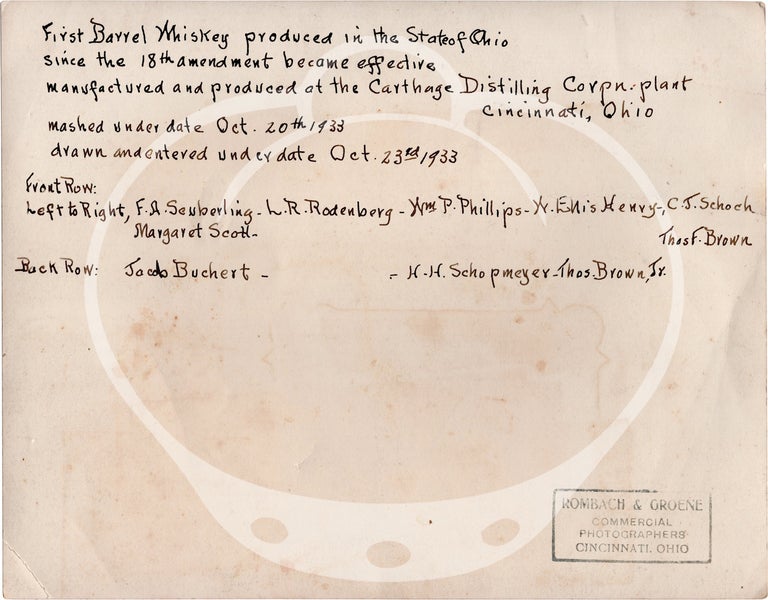Original photograph of the first legal whiskey produced during prohibition in Cincinnati, Ohio, 1933
Cincinnati: Romach and Groene, 1933. Vintage photograph of the first legal whiskey produced in Ohio during prohibition at the Carthage Distilling Company in Cincinnati, with contemporary annotations of location, dates, and personnel, and a "Rombach and Groene Commercial Photographers Cincinnati Ohio" stamp on the verso.
A fascinating prohibition artifact depicting fifteen men and one woman standing in a warehouse before a stack of three whiskey barrels, the topmost barrel prominently marked "1," less than two months before the passage of the 21st Amendment (December 5, 1933), repealing prohibition. On the verso, in a contemporary hand, is written: "First Barrel Whiskey produced in the State of Ohio since the 18th amendment became effective / manufactured and produced at the Carthage Distilling Corpn. plant Cincinnati, Ohio / mashed under date Oct. 20th 1933 / drawn and entered under date Oct. 23rd 1933."
Cincinnati, Ohio, second only to Louisville, Kentucky, in the production of bourbon prior to the end of prohibition, was best known during prohibition as the headquarters for the "King of Bootleggers," George Remus. Cincinnati was located within a 300 mile radius of 80 percent of all of America's bonded whiskeys, making it an ideal location for a massive bootlegging enterprise, as well as for the headquarters to the Schenley Distillery, one of only six distilleries nationwide with a license to sell medicinal spirits during prohibition. An October 26, 1933 article from the Cincinnati Enquirer, entitled "Big Blending Plant Planned For Reading; First Legal Whisky In Ohio Is Produced," confirms the annotations on the photograph, "Simultaneously with the actual production of medicinal whisky at its plant in Carthage—said to be the first legal whisky turned out in Ohio since prohibition—it became known yesterday that the National Distillers Products Corporation, New York, largest distiller in the country, will locate one of its major blending and bottling plants in the immediate vicinity of Cincinnati." The article continues, "The Carthage Distillery, on Anthony Wayne Avenue, Carthage, is the only distillery now operating in the state of Ohio." In 1933 the Carthage Distilling Company was acquired by the National Distillers Products Corporation and in 1987 was bought by Jim Beam.
Established in 1883, Cincinnati photographers Rombach and Groene specialized in commercial and landscape photography. In 2001 the Cincinnati Museum Center acquired the Rombach and Groene Collection, a collection of over 6,500 glass and film negatives and a hundred prints dating from 1870 to 1970. The company closed in 1973.
10 x 8 inches. Very Good, with some modest creasing, four small bruises and a small repair to the surface of the image to the center right.
[Book #157897]
Price: $300.00
See all items in: Drugs and Alcohol, Photographs, Prohibition
![[Book #157897] Original photograph of the first legal whiskey produced during prohibition in Cincinnati, Ohio, 1933. Prohibition.](https://royalbooks.cdn.bibliopolis.com/pictures/157897.jpg?width=768&height=1000&fit=bounds&auto=webp&v=1706260690)
